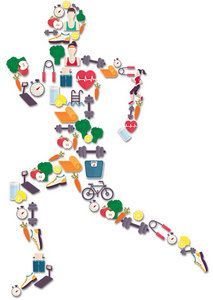You became a chiropractor to serve people, not an insurance company. You deserve to run a business that aligns with your values, supports your family and lights you up. Cash-based care isn’t just a pricing model – it’s a philosophy rooted in freedom, trust and respect for your patients and for yourself. Here's why - and how - to do it.
Detoxification for Athletes: The Key to Winning Performance
One of the most dangerous culprits that affects an athlete's ability to perform at an optimum level also happens to be one of the most elusive. Environmental toxins are virtually everywhere given their almost global nature; for instance, we don't think too much about the packaging food comes in, or the shampoo we wash our hair with – or even the air we breathe. Yet according to a 2010 article in Science, 70-90 percent of disease risks are likely due to environmental factors.1
Environmental toxins come in two categories – chemicals and metals.2-4 They are accumulated and trapped in the fatty tissue of the human body from medications, food preservatives, and exposure to pesticides, air pollutants and other harmful toxins in the environment. These toxins come from a variety of sources, but initial exposure actually begins while a baby is still in the womb.5
All-Too-Common Toxins
According to the CDC's Fourth National Report on Human Exposure to Environmental Chemicals, more than 212 chemicals have been found to be present in the blood and urine of most Americans.6 The six most widespread chemicals are:
- Polybrominated diphenyl ethers (PBDEs), used as a flame retardant
- Bisphenol A (BPA), found in plastic products (e.g. bottled water)
- PFOA, found in non-stick cookwares
- Acrylamide in items cooked at high temperatures (e.g. French fries, fried chicken and coffee
- Mercury – found in seafood
- MTBE – exposure from secondhand smoke7-9

As one example, research data suggests there is a strong relationship between urine concentrations of Bisphenol A and type 2 diabetes and reduced testosterone levels.10-11
Our liver serves as our body's natural detoxification process. It supports the body's ability to excrete toxins once they have been neutralized, thus reducing the chance they will recirculate and be stored in the body. Unfortunately, as a result of vast exposure to pervasive toxins, the liver is unable to break down fat-soluble toxins.12-14 Even in an athlete, these accumulated toxins get released back into the bloodstream. Both health and performance are impaired as these toxins recirculate in the body.
Results of Excessive Toxin Burden on Athletes
Here are some of the common symptoms that can indicate toxin overload. All of these symptoms affect an athlete's ability to train and focus, and most importantly, play on game day.:
- Fatigue, lethargy, weakness
- Depression
- Headaches, irritability
- Cognitive problems, e.g., brain fog, memory problems
- Concentration difficulties
- Generalized muscle aches
- Decreased athletic performance
Detoxification Pathways in a Healthy Liver
Step 1: Toxins, which are fat soluble, are transported from the intestine to the liver. These include metabolic end products, chemical pollutants and contaminants, micro-organisms, food additives, drugs / medications, and alcohol.15
Step 2: In the liver, toxins undergo phase 1 detoxification to neutralize certain toxins.
Step 3: The remainder of the unneutralized toxins move into phase 2 detoxification, which then transforms the remainder into water-soluble compounds.16
Step 4: Newly transformed toxins are then transported to either the kidneys, where they are excreted in the urine; or to the gallbladder, where they are eventually excreted via the feces.17-18
Detoxification Pathways in an Unhealthy Liver
In an unhealthy liver, toxins are unable to be detoxified at the speed they are brought to the liver. In these cases, toxins build up and recirculate in the blood, contributing to long-term poor health – and most importantly for athletes, impaired performance. These unneutralized, fat-soluble toxins can be stored in body tissues such as fat, the brain and the nervous system, causing systemic symptoms.19-20
The Solution: Appropriate Nutritional Support
The success of a metabolic detoxification program can be maximized by using well-researched nutrients, vitamins and herbs to balance and support the body's detoxification pathways.
The gastrointestinal tract is the first-pass detoxification barrier against large chemical compounds that are foreign to the human body. My first nutritional recommendation would be two probiotics, specifically B. lactis (Bi-07) and L. acidophilus (NCFM), which have both been documented to help with GI stability and health. Additionally, low-allergen-potential nutrients nourish the GI barrier and support the elimination of toxins.21-22
Rice proteins and medium-chain triglycerides (MCTs) derived from milk fat, palm and coconut oil boost metabolism. They allow clearance of potential allergens that may be contributing to impaired toxin clearance.
The liver is the next toxin treatment center. Nutrients that help regulate liver processes include L-cysteine, magnesium, glucuronic acid, glycine, glutathione and sulfate. Antioxidants also support the clearance of reactive intermediary compounds. A comprehensive vitamin profile, including vitamins A, C and E, and a broad spectrum of B vitamins also help neutralize these compounds.23-24
Three substances of biofunctional modulators have the ability to simultaneously influence phase 1 / phase 2 activity in the liver: green tea catechins, ellagic acid and watercress glucosinolates.25
These supplements, coupled with detox-friendly dietary intake, enable athletes to safely and efficiently remove toxins from their bodies, leading to improved health and athletic performance.
- Rappaport SM, Smith MT. Environment and disease risks. Science, 2010 Oct;330(6003):460-61.
- Lichtenstein P, et al. Environmental and heritable factors in the causation of cancer. N Engl J Med, 2000 July;343(2):78-85.
- Hindorff LA, et al. Potential etiologic and functional implications of genome-wide association loci for human diseases and traits. Proc Natl Acad Sci, 2009 June;106(23):9362-67.
- Willett WC. Balancing lifestyle and genomics research for disease prevention. Science, 2000 April;296(5568):695-98.
- Environmental Working Group. "Body Burden - The Pollution in Newborns," 2005 July.
- Fourth National Report on Human Exposure to Environmental Chemicals. Centers for Disease Control and Prevention, 2009.
- Environmental Protection Agency: Polybrominated diphenylethers (PBDEs).
- Environmental Protection Agency: Bisphenol A (BPA): Action Plan Summary.
- vom Saal, et al. Bisphenol A and risk of metabolic disorders. JAMA, 2008;300(11):1353-54.
- Ibid.
- Nakamura D, et al. Bisphenol A may cause testosterone reduction by adversely affecting both testis and pituitary systems similar to estradiol. Toxicol Lett, 2010 Feb;194(1-2):16-25.
- Fujiyoshi TP, et al. Molecular epidemiologic evidence for diabetogenic effects of dioxin exposure in U.S. Air Force veterans of the Vietnam War. Environ Health Perspect, 2006 Nov;114(11):1677-83.
- Townsend Letter for Doctors and Patients, October 2002.
- Musser W. Mitochondrial inhibitors and neurodegenerative disorders. J Neuropsychiatry Clin Neurosci, 2000May 20;12:280-281.
- Liska DJ, Bland JS. Emerging clinical science of bifunctional support for detoxification. Townsend Letter for Doctors and Patients, 2000 Oct.
- Rooney PJ, et al. A short review of the relationship between intestinal permeability and inflammatory joint disease. Clin Exp Rheumatol, 1990;8(1):75-83.
- Vree TB, et al. Effect of urinary pH on the pharmacokinetics of salicylic acid, with its glycine and glucuronide conjugates in humans. Int J Clin Pharmacol Ther, 1994 Oct;32(10):550-8.
- Zmonarski SC, Klinger M, et al. Therapeutic use of potassium citrate. Przegl Lek, 2001;58(2):82-6.
- University of Mich. School of Public Health.
- Meeker J, Ferguson K. Relationship between urinary phthalate and Bisphenol A concentrations and serum thyroid measures in U.S. adults and adolescents from the National Health and Nutrition Examination Survey (NHANES) 2007-2008. Environ Health Perspect, 2011;119(10):1396-1402.
- Asemi A, Jazayeri S, et al. Effect of daily consumption of probiotic yogurt on oxidative stress in pregnant women. Ann Nutr Med, 2012;60(1):62-28.
- Ejtahed H, Mohtadi-Nia J, et al. Probiotic yogurt improves antioxidant status in type-2 diabetic patients. Nutrition, 2012;28:539-543.
- Merck Manual of Diagnosis and Therapy, 17th Edition, Chapter 298. Whitehouse Station, NJ: Merck Sharp & Dohme, 2001.
- Sheweita SA. Drug-metabolizing enzymes: mechanisms and functions. Curr Drug Metab, 2000 Sep;1(2):107-32.
- Brown MD. Green tea (camellia sinensis) extract and its possible role in the prevention of cancer. Altern Med Rev, 1999 Oct;4(5):360-70.



